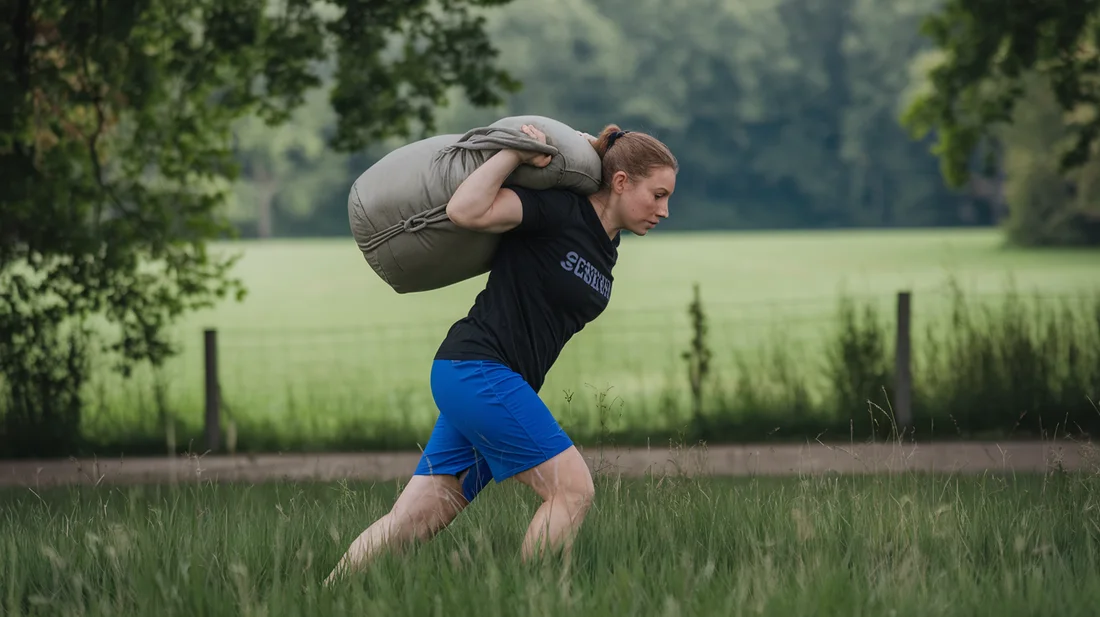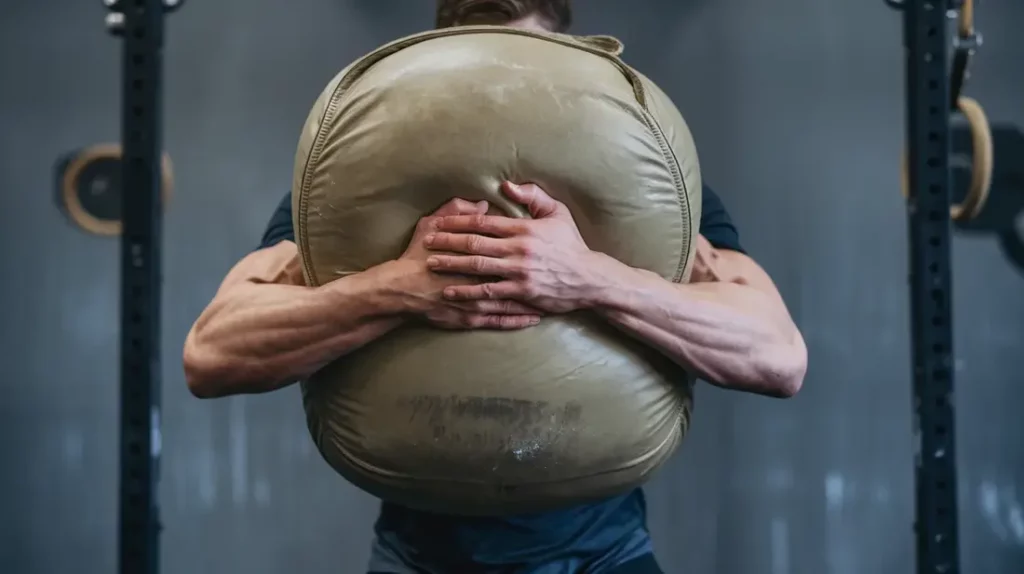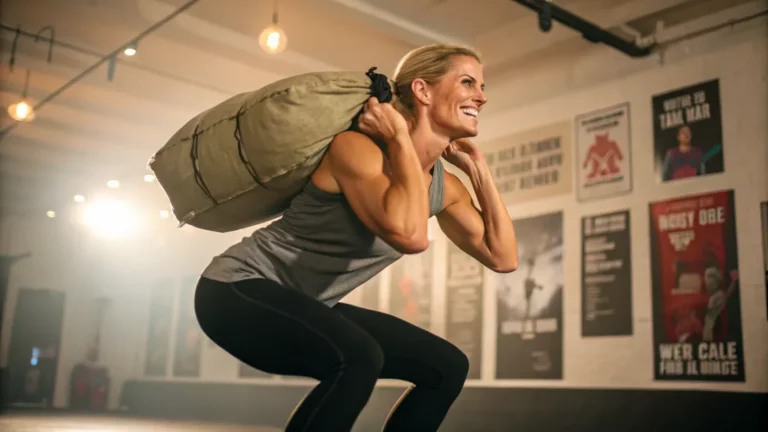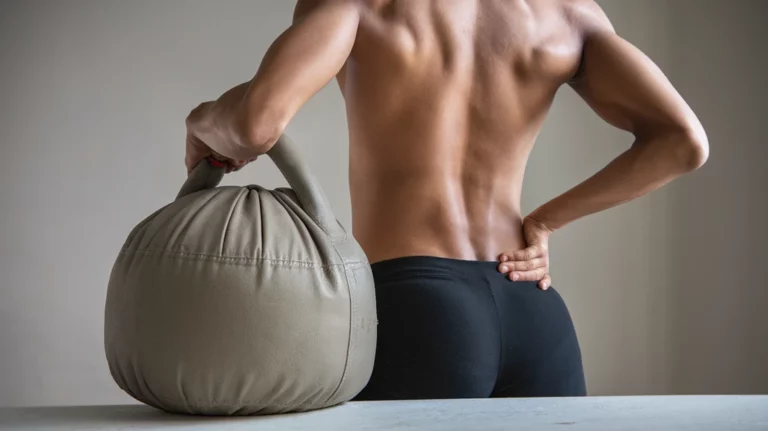Do you want to build functional strength that translates into real-world power and core stability?
Then, the answer is simple – sandbag carries.

This simple, yet incredibly powerful exercise challenges your entire body to work as a unit, and it is a great way of improving strength, endurance, posture and stability.
The sandbag carry exercise, involves holding a sandbag, and walking with it for a specified time, or distance, and this type of exercise is a fantastic tool to build real world strength.
This guide will show you the different types of sandbag carries that you can do, highlighting their unique benefits, and it will also provide you with a practical workout guide on how to do them correctly.
You will discover how to maximize your fitness with this incredibly simple, yet very effective exercise.
Understanding the Benefits of Sandbag Carries
While the sandbag carry exercise is simple, it provides a huge array of benefits.
Here’s how this exercise can transform your strength, stability, and overall fitness:
Functional Strength
- Real-World Application: Sandbag carries build a functional type of strength that translates directly to real-world activities. They are not designed to build isolated muscles, but to build strength in a way that can be applied to your daily tasks, as well as sports and other physical activities.
- Practical Strength: These exercises mimic everyday tasks, like carrying groceries, luggage, or moving objects, and this will allow you to do those tasks with more strength, power and less chance of injury.
- Full Body Engagement: They engage your entire body, including your legs, core, back, and arms, all working together in a coordinated way.
Core Stability
- Unstable Load: The shifting weight of a sandbag, forces your core muscles to engage constantly to stabilize your body during the carry. This constant activation will improve your core stability and core strength.
- Better Control: Having a strong core provides greater stability, balance, and control over your body, which will improve your ability to maintain good posture, and prevent injury. This will also be very helpful in a wide range of activities.
Grip Strength
- Build Hand and Forearm Strength: The act of holding and controlling a sandbag, requires you to engage the muscles in your hands, fingers and forearms, which over time will increase your grip strength, and improve your overall strength.
- Carry Heavy Objects With Ease: This increased grip strength will improve your ability to carry heavy objects, and also to perform a range of other exercises.
Endurance
- Cardiovascular Health: Sandbag carries build muscular endurance by challenging your body with repeated movements under load.
- Fatigue Resistance: This will help you to build up your tolerance to fatigue, and improve your ability to perform physical activities for prolonged periods, which can translate into real-world benefits, as well as other physical activities.
Mental Toughness
- Overcoming Challenges: The often uncomfortable nature of sandbag carries pushes you to overcome physical and mental barriers. This improves your mental toughness, and will help you to approach challenges in your life with greater confidence.
- Improved Resilience: Learning how to embrace the discomfort of sandbag carries, improves resilience and helps you to keep pushing, even when things are tough.
- Discipline and Commitment: They also develop the discipline and commitment needed to push through challenges.
Types of Sandbag Carries
While the sandbag carry exercise is a simple movement, it has many variations, and each type of carry offers unique benefits, and instructions that are designed to target different muscle groups and provide a greater challenge.
Here’s a short description of how they differ:
Remember to always focus on maintaining proper form, and to listen to your body while you are performing each exercise.
- Sandbag Bear Hug Carry: The sandbag is held tightly against your chest, which targets your core muscles, and is useful for building core strength, stability and grip strength.
- Zercher Carry: The sandbag is held in the crook of your elbows, which targets your core, upper back and arms. This carry is ideal for building overall strength and stability, as it requires a lot of full body engagement.
- Sandbag Shoulder Carry: The sandbag is held on one of your shoulders, and is a great way to target your traps, shoulders, back and core. It is also useful for improving your balance.
- One Shoulder Carry: The weight is carried on one shoulder.
- Alternating Shoulder Carry: The weight is switched from shoulder to shoulder at regular intervals.
- Sandbag Front Carry: The sandbag is held in front of your chest, and this is a great way to build upper back and core strength.
- Sandbag Back Carry: The sandbag is held on your back, and this engages the lower back muscles, core, and legs. This is a more challenging carry, that builds endurance and strength.
Sandbag Bear Hug Carry

- Instructions: Hug the sandbag tightly against your chest. Engage your core and walk forward for a specific distance or time, making sure to maintain an upright posture. You must keep the bag tightly secured against your chest, and you should be focusing on your core.
- Benefits: Improves core strength and stability, grip strength, and full body engagement. This also helps to build endurance, and will challenge your entire body. It is also a great way of working on your posture.
- Safety Tips: Keep your back straight, core engaged, and avoid hunching forward or using momentum. Always be aware of your environment.
Zercher Carry
- Instructions: Hold the sandbag in the crook of your elbows, keeping your forearms parallel to the ground and your back straight. Walk forward, while maintaining good posture.
- Benefits: Develops core strength, upper back and bicep strength, and will improve your overall strength and stability. This will also challenge your mental toughness, as it can be a very uncomfortable carry.
- Safety Tips: Keep your back straight, and your core engaged, and do not over extend your back. Only use a weight that you can handle.
Sandbag Shoulder Carry

- Instructions: Lift the sandbag and place it on one of your shoulders, making sure that it is supported, and that you can comfortably walk with it. Keep your core engaged, and your back straight, and walk forwards.
- One Shoulder Carry: You will carry the sandbag on one shoulder, for a specific distance or time.
- Alternating Shoulder Carry: You will perform the carry, while also switching sides at set intervals.
- Benefits: Improves core strength and stability, shoulder strength and traps strength, as well as balance. It also tests your endurance, and is a great workout for multiple muscles.
- Safety Tips: Keep your core engaged, and avoid rounding your back. Ensure that the weight is stable on your shoulder. Make sure to alternate sides regularly to maintain a balanced training routine, and to avoid overstraining one side.
Sandbag Front Carry

- Instructions: Hug the sandbag to your chest, while keeping your back straight and your core engaged, and walk forward for a set distance, or time. You can hold the sandbag in front of you, if you find this more comfortable. The key is to ensure you are keeping your core tight, and your back straight.
- Benefits: Builds upper back and core strength, and is a great exercise for improving your posture, and your ability to stabilize your core during movement.
- Safety Tips: Engage your core, keep your back straight, and avoid hunching forward or using momentum. You can also vary your grip to find the most comfortable grip position.
Sandbag Back Carry

- Instructions: Place the sandbag on your upper back, and secure it with your hands, to ensure that it does not fall off. Walk forward, engaging your core, and keeping your back straight. If you are unable to hold it on your upper back, you can carry it lower down your back, in a horizontal position.
- Benefits: Strengthens your lower back, as well as your core and legs. This will provide you with greater strength and overall stability.
- Safety Tips: Ensure you are engaging your core muscles throughout the exercise, to avoid lower back pain, and to prevent injury. Keep your back straight and make sure the sandbag is not too heavy.
- You must also make sure that the sandbag is secured to your back, so that it does not fall off.
“Beyond the Basics” – Variations
- Incline: Try performing any of these carries on an incline, to add an extra level of difficulty.
- Uneven Surfaces: Try to do the carries on uneven surfaces, to improve your stability.
- Weight: As you progress, you can increase the weight, to challenge your body further.
- Time or Distance: You can also vary the duration of the carry, or the distance that you walk.
How to Perform Sandbag Carries Correctly
To get the most out of the sandbag carry exercise, it is important to focus on proper technique, and to avoid common mistakes.
These guidelines will help you to perform the exercises correctly and safely.
Key Points for Proper Form
Foot Placement and Posture:
- Stand with your feet shoulder-width apart, with your core engaged, and your back straight.
- Keep your head up and look forwards. This will ensure that you are maintaining a good posture.
Core Engagement
- Engage your core muscles throughout the exercise, to provide support for your spine, and to keep you stable during the movement.
- Make sure to actively squeeze your abs, and imagine pulling your belly button in towards your spine.
Grip and Hand Placement
- Maintain a firm and comfortable grip on the sandbag, using both hands.
- Adjust your hand placement based on the type of carry, and always maintain a strong grip to ensure that you do not drop the bag.
Common Mistakes to Avoid
- Rounding Your Back: Avoid rounding your back. Keep your back straight to protect your lower back, and avoid injury.
- Hunching Forward: You must avoid hunching forward, as this can cause strain and pain. Always look straight ahead, and make sure to maintain good posture.
- Using Momentum: Do not rely on momentum to move the sandbag. The movements should be slow, and controlled, using your muscles, and not momentum.
- Using Poor Form: Make sure that you have focused on the technique, and that you have mastered the movement, before you start to use a heavier weight.
- Using an Unsuitable Weight: Do not use a weight that is too heavy, as this will lead to a higher chance of injury. You should only use a weight that you can comfortably manage whilst also performing the exercises with good form.
Safety Precautions
- Check the Sandbag: Before beginning the exercise, always check the sandbag for any holes, or tears. Make sure that the handles are securely attached. If the sandbag is damaged, you should use a different sandbag for the exercise.
- Clear Path: Ensure that your path is free from obstacles or anything that may cause you to trip or fall, as you are performing the exercise.
- Proper Footwear: You should also ensure that you are using footwear that is suitable for working out.
- Listen to Your Body: It is vital that you always listen to your body, and stop the exercises immediately if you feel any pain or discomfort, and seek medical advice where needed.
Integrating Sandbag Carries into Your Workout Routine
Sandbag carries are a very versatile exercise, and they can easily be added to your existing workout routine, to help you to reach your fitness goals.
Here’s how to effectively integrate them into your fitness plan:
Workout Ideas
- For Strength:
- Heavy Weight, Shorter Distance: Use a heavier sandbag, and perform the carries for shorter distances (e.g. 20-30 feet), focusing on controlled movements and proper technique. This is great for building overall strength and power.
- Combine with other exercises: You can also combine the sandbag carries with other strength exercises, such as squats, rows and lunges, to build a strong and functional workout routine.
- For Endurance:
- Lighter Weight, Longer Distance: Use a lighter sandbag and perform the carries for longer distances, such as 50-100 feet, focusing on consistency and pacing. This will help to improve endurance and fatigue resistance.
- Time-Based Intervals: Focus on walking for a set amount of time, and try to improve your stamina. You can start with 30 seconds and try to increase this to 60 seconds, and beyond.
- For Core Stability:
- Vary Carry Positions: You can do variations such as the sandbag bear hug carry, or the shoulder carry, to challenge your core muscles from different angles. You can also try to perform the exercises on unstable surfaces to make it even harder.
- Incorporate Other Exercises: Combine sandbag carries with core exercises, such as planks, Russian twists, and dead bugs, to improve your core stability, and muscle endurance.
Workout Frequency
- Start Slowly: If you are new to sandbag training, start with just 1-2 sessions per week and gradually increase as your body adapts.
- Listen to Your Body: The number of times that you workout every week, will depend on your current fitness levels, and your goals. You must always listen to your body, and avoid over training, as this will only increase the risk of injury.
Progression
- Increase Weight: As you get stronger, slowly increase the weight that you are using for the carries, and ensure that you are maintaining proper form and technique.
- Increase Distance: You can also increase the duration or distance of the carry, to challenge yourself. You should only increase the intensity when you feel that your current workload has become easy.
- Add Variations: You can add different variations, to make the exercises more challenging and also to train the muscles in different ways.
Rest and Recovery
- Rest Days: Make sure to allow adequate rest days between sandbag carry workouts, to allow your body to recover.
- Recovery: Ensure that you are getting enough sleep, and eating a healthy diet. If you are not recovered, then you must adjust your training routine.
- Active Recovery: Try using light activities, such as stretching, or yoga, to improve circulation and to aid in recovery.
Choosing the Right Sandbag for Carries
Selecting the right sandbag for carries is important to ensure that you are performing the exercises correctly, and that you are getting the maximum benefit from each workout.
You must also choose a sandbag that is suitable for your body, and your fitness levels.
Here’s a breakdown of key factors to consider when choosing a sandbag for this type of training:
Weight Recommendations
- Based on Fitness Levels:
- Beginners: Start with a lighter weight (10-20 lbs) to focus on mastering the correct form and technique, and to make sure that you are engaging your core muscles.
- Intermediate: Gradually increase to a medium weight (20-40 lbs), as you build more strength and stability.
- Advanced: Use heavier weights (40 lbs and above) for a greater challenge and to improve your endurance, power and strength.
- Based on the Type of Carry:
- For exercises like the bear hug, you might be able to use a slightly heavier weight, as this is a stable carry, where the weight is close to your body.
- For carries where the weight is held further from the body, such as the sandbag shoulder carry, you will need a lighter weight to ensure that you can perform the exercises safely, and effectively, and that you do not compromise your form.
- You should always experiment and use different weights, to see what feels comfortable, and you should never train through pain.
Handle Types
- Grip Options: Look for a sandbag with multiple handles. Handles on the sides, top and ends will provide more versatility, and allow for a wide range of exercises.
- Comfort: The handles should be comfortable to hold and should be durable, to withstand repeated use.
- Placement: Ensure that they are strategically placed for different grip positions.
Size and Material
- Compact Size: Opt for a bag that is not too bulky or awkward. A compact and medium sized sandbag is the best option for performing sandbag carries.
- Durable Material: Use a durable material, such as heavy-duty nylon or reinforced canvas, as this will provide strength, and ensure that it will last for a long period of time.
- Easy to Handle: The sandbag should be easy to handle and maneuver.
DIY Options
- Duffel Bag: A durable old duffel bag is a great option for creating a low cost sandbag. It should have a strong material, and a reliable zip.
- Heavy-Duty Bag: A heavy-duty bag with a zipper is another useful option, that is both cost effective and easy to create.
- Inner Fillers: If you are using a DIY sandbag, always use strong inner liners such as heavy-duty garbage bags, or water proof bags, to keep the sand from spilling out.
Key Takeaways
- Weight: Always choose the weight that is suitable for your fitness level.
- Handles: Choose a sandbag that has multiple handles, so that you can vary the grip.
- Size and Material: Choose a size and material that is easy to use, and that is comfortable for you.
- DIY Options: If you are on a budget, then you can create your own sandbag, using low cost materials.
FAQ (Frequently Asked Questions)
Here are some of the most common questions about sandbag carries, along with practical and concise answers:
What is the best sandbag carry exercise?
There isn’t one “best” exercise, as the effectiveness depends on your fitness goals, and your individual requirements.
- Bear Hug Carry is great for core and grip strength.
- Zercher Carry will improve your core, and upper back muscles, and will improve your ability to stabilize the body.
- Sandbag Shoulder Carry is good for balance and full body engagement.
You should always focus on doing the carries correctly, using good form, and focusing on engaging the correct muscles.
The best approach, is to experiment and see which types of sandbag carries feel the most suitable for you.
How do you progress from basic sandbag carries?
- Increase Weight: As you get stronger, you can gradually increase the weight of the sandbag.
- Increase Distance: You can increase the distance of the carries, to challenge your endurance and stamina.
- Add Variations: Add more advanced variations, such as the Zercher carry, and the alternating shoulder carry, to challenge your body further.
- Try Different Surfaces: You can also try doing the carries on different surfaces, such as walking on a hill, or an uneven surface, to challenge your stability, and core control.
What do sandbag carries work?
- Full Body Engagement: Sandbag carries are a great full body workout, and engage your legs, core, back, and arms.
- Core Strength: These exercises are particularly effective for improving your core strength and stability.
- Grip Strength: They also improve your grip strength, and build endurance, as well as mental toughness. They will also improve your overall functional strength, and mobility.
- You will also see an improvement in your posture and overall body control.
Are sandbag carries suitable for beginners?
- Yes, sandbag carries are suitable for beginners. You must start with a lighter weight, and use correct technique, and use a style of carry that is suitable for you.
- You should focus on mastering the basic carries first, and then you can move on to the more complex exercises. You must always listen to your body, and you should stop exercising immediately if you feel any discomfort. You may also need to take rest days, and you should not over train.
Conclusion – Build a Stronger You with Sandbag Carries
You now have a comprehensive guide to understanding the power of the sandbag carry exercise.
It’s a simple yet potent tool for building functional strength, core stability, and overall resilience, and it will also help you with everyday tasks.
This exercise will transform your approach to fitness, and it will give you a new understanding of the power of a simple movement, when performed consistently, and with intention.
Let’s recap the key benefits of this versatile exercise:
- Full Body Strength: You will build full body strength by engaging your core, back, legs, arms and grip strength, all with just one piece of equipment.
- Core Stability: You will improve your core strength and core stability, which is essential for improving your posture, and for everyday activities, and athletic performance.
- Endurance: You will improve your endurance, and you will be able to perform exercises for longer without feeling fatigue.
- Mental Toughness: By overcoming the challenges of sandbag carries, you will develop greater mental toughness, and resilience.
It’s time to take action, and implement the sandbag carry exercise into your routine, and begin to experience the massive benefits of this simple, yet highly effective exercise.
Start slowly, master the technique, and gradually increase the intensity over time.
Take control of your fitness and build a stronger you with the power of the sandbag carry.
Citations
- Functional Strength & Sandbag Training
McGill, S. (2010). Core training: Evidence translating to better performance and injury prevention. Strength & Conditioning Journal, 32(3), 33-46. https://journals.lww.com/nsca-scj/fulltext/2010/06000/core_training__evidence_translating_to_better.4.aspx - Unstable Load & Muscle Activation
Behm, D. G., Leonard, A. M., Young, W. B., Bonsey, J., & McNaughton, L. R. (2010). Trunk muscle electromyographic activity with unstable and unilateral exercises. Journal of Strength and Conditioning Research, 24(9), 2486–2495, https://pubmed.ncbi.nlm.nih.gov/15705034/



